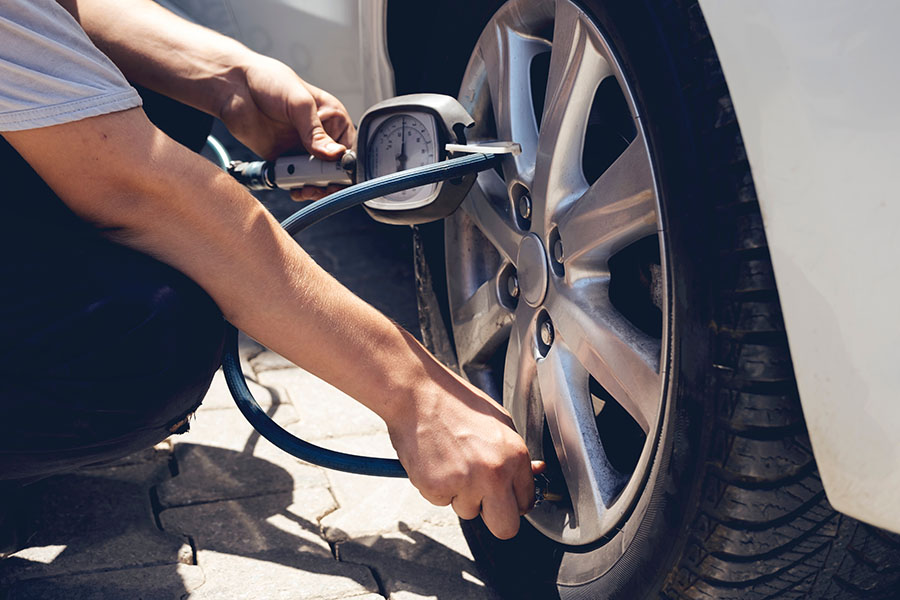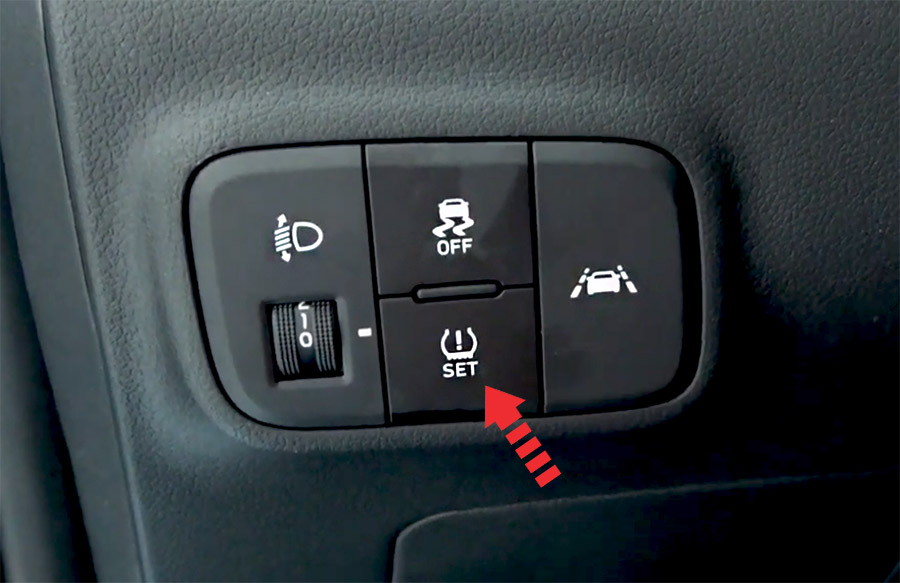Hyundai i10 is equipped with Tire Pressure Monitoring System (TPMS) for the purpose of warning the driver when one or more of the tires are significantly under-inflated, creating a potentially unsafe driving condition. In this article we discuss the reasons for the amber colored TPMS warning light in i10, and how you can reset it.

The TPMS warning light illuminates in Hyundai i10 when air pressure is low in one or more of the tires, or there is a malfunction in one of the ABS speed sensors.
Low tire pressure
When the amber colored TPMS warning light  turns on in your i10, stop your vehicle when it is safe to do so and check tire pressure on all the wheels, including the spare wheel (if your vehicle has one). Driving on a significantly under-inflated tire causes the tire to overheat and can lead to tire failure.
turns on in your i10, stop your vehicle when it is safe to do so and check tire pressure on all the wheels, including the spare wheel (if your vehicle has one). Driving on a significantly under-inflated tire causes the tire to overheat and can lead to tire failure.

Reinflate the tires
Reinflate all the tires of your i10 to the manufacturer specified air pressure, which is mentioned on the vehicle placard or tire inflation pressure label usually located on the B-pillar or the edge of the driver door. If you can’t find the label, check the size of your tire which is mentioned on the sidewall of the tire, and match it to the tire pressure information shown below. These are official cold tire pressure values for 3rd generation i10 from Hyundai.
- 175/65R14: Front: 230 kPa, 33 psi | Rear: 210 kPa, 30 psi
- 185/55R15: Front: 230 kPa, 33 psi | Rear: 210 kPa, 30 psi
- 195/45R16: Front: 230 kPa, 33 psi | Rear: 210 kPa, 30 psi
- T115/70D15 (spare tire): 420 kPa, 60 psi

Resetting the TPMS warning light
After you have inflated all the tires to the correct air pressure, you must reinitialize the TPMS system. Hyundai i10 TPMS system monitors and compares the rolling radius and rotational characteristics of each wheel and tire whilst you are driving. And it checks whether any tire is significantly under-inflated. You should reset the system by pushing the TPMS SET button according the accurate procedure and store the current tire pressure.
After that, if one or more tires are significantly under-inflated, the low tire pressure indicator illuminates and a message is shown on the cluster. Also, if there is a malfunction with the TPMS, the TPMS malfunction indicator will illuminate.
You should reset TPMS in below situations.
- After repairing or replacing tires or wheels.
- After rotating tires.
- After adjusting tire pressure.
- When the low tire pressure indicator illuminates.
- After replacing suspension or ABS system.
TPMS Reset Procedure
- Park the vehicle on a level, firm surface.
- Inflate the tires to the proper pressure as indicated on the vehicle’s placard or tire inflation pressure label located on the driver’s side center pillar outer panel.
- Start the engine, press and hold the TPMS SET button for about three seconds to reset TPMS. The reset process completes automatically.
- Then check that the low tire pressure indicator turns off after blinking for four seconds. In case of supervision cluster, check that “Tire pressures stored” message is shown on the cluster.
- After resetting the TPMS, drive the vehicle for approximately 20 minutes to store the new tire pressure in the system.

Note: If the low tire pressure indicator turns on repeat step 3. When resetting TPMS, the current tire pressure is stored as a standard tire pressure.
WARNING! Without inflating the tires, if you reset TPMS, the system may not inform you even if the tires are significantly underinflated. You must check the proper tire pressure before resetting TPMS.
Chilly weather can turn on low tire pressure light in i10
Cold weather can cause low tire pressure in Hyundai i10, but since the vehicle has an indirect TPMS system, the warning light will not turn on as the air pressure drops in all wheels simultaneously with temperature drop.
The rotational speed of all wheels remain the same and TPMS warning light remains off. Therefore when the weather gets cold, you should check the tire pressures.

The air, like most other substances, expands when heated and contracts when cooled. So when the weather gets colder, the tire pressure decreases, which could trigger TPMS warning light in i10. The tire pressure will vary with temperature by about 1 psi (7 kPa) for every 12°F (6.5°C).

Inflate tires when cold
Tire pressure in i10 should always be set based on cold inflation tire pressure. This is defined as the tire pressure after the vehicle has not been driven for at least three hours, or driven less than 1 mile (1.6 km) after a three-hour period.
Do not adjust tire pressure when hot
The tires on your i10 can get around 50 degrees hotter than the outside temperature when you’re driving, which increases the tire pressure by about 4 psi – this is normal and there should be no adjustment for this increased pressure.
Does altitude affect tire pressure?
Yes, altitude can change tire pressure values, but it is negligible and not a cause for concern. If you drive your i10 from sea level to Mount Evans Scenic Byway in Colorado which is the highest paved road in North America at the altitude of 14,130 feet (4,307 m), the tire pressure should theoretically increase by approximately 6 psi. But, the decrease in ambient temperature at higher elevation contracts the air in tires and compensates for any altitude pressure changes.
Is it safe to drive i10 with low tire pressure?
The driving characteristics of i10 change even if the air pressure is 5 psi less than manufacturer’s recommended value: the braking distance can be longer, cornering worse, and at particularly high speeds there is even a risk that the tire will burst. Low tire pressure also increases tire wear, and the higher rolling resistance of the tire means higher fuel consumption. So it is recommended to reinflate the tires to the correct pressure as soon as possible.
Tire pressure keeps getting low
If the TPMS warning light turns on frequently in your i10, and the tire pressure is also decreasing after you have reinflated the tires, there may be an air leak. One or more of the tires may have been punctured by an external object, or the air may be leaking from a defective value stem.



